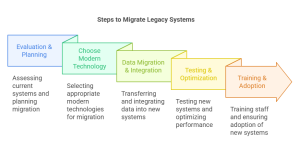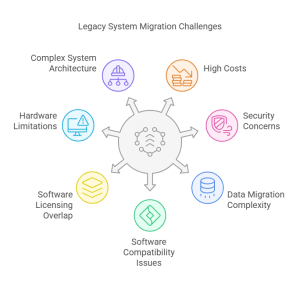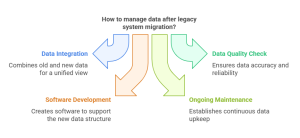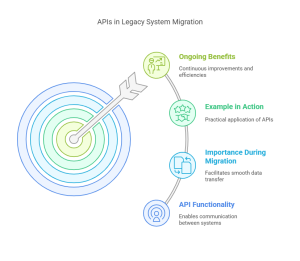Legacy systems have played a big role in helping businesses grow. They were once the foundation of daily operations and got things running smoothly. But as technology evolves, these older systems are becoming more of a problem than a solution.
Today, businesses need fast, secure, and flexible systems to stay competitive and legacy software often can’t keep up. It can slow down your team, increase costs, limit growth, and put your data at risk. The longer you delay upgrading, the harder and more expensive it becomes.
We get it, change can feel tough. Legacy systems are familiar and deeply tied to how your business runs. But sticking with outdated tools can quietly hold you back.
Upgrading to a modern system, also known as legacy system migration or digital transformation, may seem like a big task. But the benefits are worth it better performance, improved security, easier maintenance, and more room to grow.
In this guide, we’ll break down what legacy migration really means, why it matters, and how to approach it with a smart plan, so you can move forward with confidence and set your business up for long-term success.
What Is Legacy System Migration?
Legacy system migration means moving old or outdated software to a newer and more modern platform. This process can include upgrading the system, rebuilding it with new tools, or completely replacing it with a better solution.
The goal? To help businesses keep up with current technology, work faster, stay secure, and grow. For example, a company might move its old desktop-based software to a cloud-based system to improve access, flexibility, and performance.
What Is a Legacy Application?
A legacy application is software that runs on old technology and often lacks support or updates. These systems can be slow, hard to maintain, and expensive to keep running. In some cases, the company that built the software may not even exist anymore.
Despite their age, many businesses still rely on legacy apps for everyday work—especially in industries like banking, insurance, and manufacturing. But holding on to these outdated systems can slow down operations, limit growth, and increase IT costs.
Modernizing them isn’t easy, but it’s a smart move for businesses that want to stay competitive and efficient.
Why Do Businesses Hold On?
Simple: familiarity. Your team knows the system, it still “works,” and change is scary. But clinging to old tech creates more problems than it solves, security holes, limited functionality, rising maintenance costs, and missed opportunities for growth.
Also Read: How AI-Powered Apps Are Transforming Small Business Efficiency
The Importance of Migrating to Modern Applications

Modernizing your legacy systems isn’t just a tech upgrade, it’s a strategic move that can transform the way your business operates. Here’s why it’s so important:
1. Embraces Modern Technology
Migrating from outdated systems to modern platforms, especially cloud-based ones, unlocks access to powerful technologies like AI, machine learning, and big data analytics.
You’ll benefit from real-time data access, easier support for remote teams, and automatic backups. Unlike legacy systems that need downtime for updates, modern solutions can be upgraded quickly and seamlessly.
2. Boosts Performance and Efficiency
Outdated software often slows teams down. After migrating, you’ll notice faster operations, fewer crashes, and smoother workflows.
Employees won’t have to rely on workarounds or spend time fixing broken processes. Cloud storage also improves data speed and reliability compared to old local systems, which often lag or risk data loss.
3. Enhances Compatibility and Scalability
Legacy systems don’t play well with modern tools, making it difficult to integrate mobile apps, web platforms, or third-party software.
A modernized system allows your tech to work together more effectively, with smooth data sharing and integration. And because cloud-based infrastructure doesn’t rely on physical hardware, scaling your operations is faster and more cost-effective.
4. Strengthens Data Security
Old systems might feel secure, but they’re actually more vulnerable to breaches and viruses due to outdated security measures.
Steps to Successfully Migrate Legacy Systems

1- Evaluation & Planning
Assess current systems, define success, and align migration with business goals.
2- Choose the Right Modern Technology
Select platforms that meet your needs—cloud-native, SaaS, microservices, etc.
3- Data Migration & Integration
Migrate clean, secure data. Ensure your new system integrates smoothly with existing tools.
4- Testing & Optimization
Run performance, security, and usability tests to catch issues early.
5- Training & Adoption
Equip your team to succeed with the new system. Build confidence, not confusion.
Challenges of a legacy system migration

Moving away from legacy systems can be a big step and while the benefits are worth it, there are several challenges to consider. Legacy systems are often deeply embedded in your day-to-day operations, so replacing them takes planning and care. Here are some of the most common hurdles businesses face:
1. High Costs and Ongoing Maintenance
Modernizing your systems often requires a significant initial investment, but that’s not the only cost to plan for. Ongoing expenses like cloud storage, monitoring tools, and system updates can add up over time. If you’re connecting old and new systems using middleware (like an ESB), you’ll also need to account for costs related to training, technical support, and patch management.
2. Security Concerns
Legacy systems tend to be patched together over the years, which can leave behind undocumented fixes and vulnerabilities. During migration, those weak spots might resurface if not carefully managed.
Also, some parts of the migration process may need to be done manually, especially data transfer, which increases the risk of human error and system downtime.
3. Data Migration Complexity
Migrating data is one of the most sensitive parts of the process. Before moving anything, you need to audit your data: What needs to be moved? What format will it take? What should be left behind?
There’s also the risk of data corruption or loss, so creating backups and having a solid disaster recovery plan is essential. Data protection must be a top priority throughout the migration.
4. Software Compatibility Issues
If your legacy system relies on outdated software or custom-built integrations, they may not work with your new setup. You’ll need to identify all your current applications, especially the ones with custom connections and make sure they can work with the new system, or plan for replacements.
5. Software Licensing Overlap
Switching to a new system may require new licenses and during the transition period, you might have to pay for both the old and new software at the same time. Choosing software that supports multi-cloud environments can help reduce this cost and simplify deployment.
6. Hardware Limitations
Some legacy systems depend on very specific hardware or operating systems. If your new platform isn’t compatible, you may need to upgrade your hardware too, which can increase the overall cost. In cases where the vendor no longer supports your existing equipment, you’ll need to verify whether your apps can still run on newer platforms.
7. Complex System Architecture
Legacy systems are often connected to many applications and databases, forming a tightly woven web. That makes it hard to simply “lift and shift” them to a new environment. If one piece is moved without adjusting the others, it could lead to unexpected downtime or performance problems. That’s why a detailed migration plan is critical before starting the process.
What to Do with Your Data After Migrating Your Legacy System

Completing a system migration is a major achievement—but it’s not the finish line. To make the most of your modern setup, you need a strong post-migration data strategy that ensures everything remains organized, accessible, and secure.
1. Combine Old and New Data (Data Integration)
Once migration is complete, your first step is to ensure data from your legacy systems and new systems are compatible and work well together.
Data integration combines information from multiple sources into one unified system.
This ensures your teams can access the data they need without switching platforms or re-entering information.
2. Check and Maintain Data Quality
Clean, reliable data is essential to get the most from your new system.
Review your existing data to remove outdated, duplicate, or inaccurate records.
Implement regular data checks to keep it current and useful for long-term operations.
3. Develop Software That Supports the New Structure
Modern systems often require new tools or updates to existing ones to function properly with the new data model.
Build or customize applications that support how your data is stored and accessed.
Make sure all tools are compatible with your current system and scalable for future growth.
4. Set Up Ongoing Data Maintenance
A good post-migration strategy isn’t just about the present, it’s also about long-term data health.
Schedule regular data backups.
Run audits and health checks to catch potential issues early.
Keep your software updated to protect against security risks
How APIs Make Legacy System Migration Smoother

APIs (Application Programming Interfaces) are one of the most valuable tools you can use during a legacy system migration. They act like translators, allowing different systems, old and new, to communicate effectively and share information.
1. What Do APIs Do?
APIs allow software applications to exchange data and functionality.
They connect your legacy system with your new tools, making it possible to transfer data and maintain operations during the switch.
2. Why Are APIs Important During Migration?
They bridge the gap between outdated and modern platforms.
APIs reduce manual data entry and human errors by automating information flow.
They minimize downtime by allowing old and new systems to run in parallel.
3. Example in Action
Let’s say you’re migrating from an old accounting platform to a new one:
An API can automatically sync your financial data between the two systems.
You avoid data loss and maintain business continuity throughout the transition.
4. Ongoing Benefits After Migration
Even after the migration is complete, APIs continue to add value:
Enable seamless integration with other tools (e.g., CRM, reporting systems).
Improve flexibility as your software ecosystem grows and evolves.
Real-World Example: Insurance Firm Modernizes Legacy CRM
A mid-size insurance firm relied on a 15-year-old on-premise CRM. Customer service was slow, remote access was nonexistent, and maintenance costs were sky-high.
What they did:
They replatformed to a modern, cloud-based CRM with API integrations to their claims system.
Results:
- 40% faster customer response times
- 20% reduction in operational costs
- Happier, more efficient remote workforce
Why Partner with BitsWits for Legacy System Migration
Migrating legacy systems isn’t just about tech, it’s about strategy.
BitsWits bring:
- Proven migration frameworks
- Deep experience in data mapping, compliance, and risk reduction
- Tools to minimize downtime and disruptions
We ensure your legacy system upgrade goes smoothly, so your team stays focused on growth, not fire-fighting.
With BitsWits Experts, legacy system migration is simple, secure, and stress-free. We handle the hard part, so you can focus on growing your business with modern tools, better performance, and stronger security. Let’s future-proof your operations today.
Conclusion
Legacy systems were built for the past. But your business? It’s built for the future.
Upgrading isn’t easy, but with the right migration strategy and expert support, it can be seamless, and transformational. You’ll unlock new efficiencies, wow your customers, and future-proof your business.
















